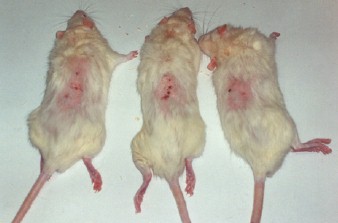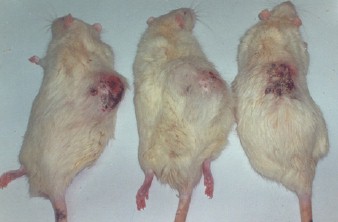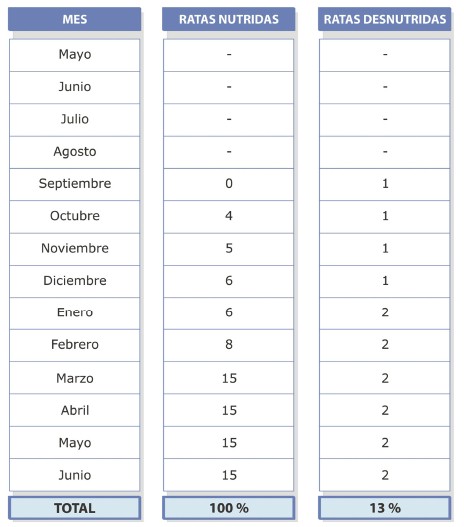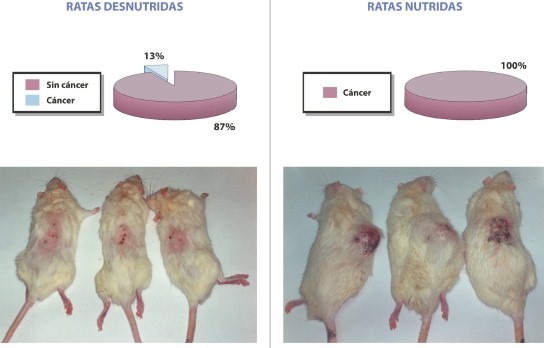
Organismos nutridos
Anteriormente ya hemos expuesto la diferencia que existe entre un organismo desnutrido y el nutrido. En la figura 6 vemos claramente los porcentajes de la formación tumoral entre unas ratas y otras.
A todas las ratas (nutridas y desnutridas) se les aplicó el mismo cancerígeno y con idénticas dosis. En la figura 6 se aprecia la diferencia existente de peso y volumen entre las ratas desnutridas y las bien alimentadas.

Tabla 2. Organismos nutridos y desnutridos.

Figura 6. Organismos nutridos y desnutridos.

Bibliografía
1. TANNENBAUM, A.: “The initiation and growth of tumours. Effect of underfeeding”. Am. J. Cancer, 38, 335-350. (1940).
2. NELSEN, F. AND PLADZIEWICZ, J. R. “Intermolecular electron transfer reactivity determined from cross-rate studies”. Accounts Chem. Res., 35, 247-254. (2002).
3. IVERSEN, O.H. “The skin tumorigenic and carcinogenic effects of different doses, number of dose fractions and concentrations of 7, 12-dimethylenz(a)anthracene in acetone applied on hairless mouse epidermis. Possible implications for human carcinogenesis“. Carcinogenesis. Páginas 12, 493-502. (1991).
4. HENNINGS, H., SHORES, R., WENK, M.L., SPANGLER, E.F., TARONE, R. AND YUSPA, S.H. “Malignant conversion of mouse skin tumours is increase by tumour initiators and unaffected by tumours promoters”. Nature, 67-69, 304. (1983).
5. RIBAS, B., GARCÍA ARRIBAS, O., PÉREZ CALVO, M. AND GARCÍA FÉRRIZ, P. “Some data on the comparison between the eukaryotic cell electric activity and the electromagnetic hypersensitivity syndrome”. ELSAF (2001), Wroclaw, Poland.
6. ORTUÑO ORTIN, M.; “Física para Biología, Medicina, Veterinaria y Farmacia”. 1ª edición. Editorial Hurope, S.L. Recared, 2. 08005. Barcelona. Páginas 331, 400, 401. (1996).
7. DR. DALE DUBIN; “Electrocardiografía Práctica”. 3ª edición. Editorial McGraw-Hill Interamericana. Páginas 8, 9, 23, 73, 74, 76, 77 y 153. (2000).
8. MORROS SARDÁ, J.; “Elementos de Fisiología”. 8ª edición. Editorial Científico-Médica. Páginas 71, 1.069. (1961).
9. GARCÍA FÉRRIZ, P.; “Origen del Cáncer”. Páginas 18, 19, 22, 24-27, 32, 36-39, 43, 47-49, 100 y 101. (2003) (SIN PUBLICAR)
10. TESTUT-LATARJET; “Anatomía Humana”; tomo 2º. Editorial Slava Editores, S.A. (1975).
11. LATARJET-RUIZ LIARD; “Anatomía Humana”; tomo 1º. 3ª edición. Editorial Médica (Panamericana). Página 199. (1999).
12. C. WALTON SWOOPE; “Curso Completo de Electricidad”; 3ª edición. Editorial Bailliri, S.A. Madrid. (1941).
13. WILLIAM H. TIMBIE; “Elementos de Electricidad”; 3ª edición. Editorial Bailly Bailliere, S.A. Madrid. (1941).
14. KADEL, E., JESSELL, TH. M. y SCHWARTZ, J.; “Neurociencia y Conducta”; 2ª edición (J. Stummpf, ed.), Impr. Grafilles, Madrid. Páginas 25, 33, 35, 47, 51, 67, 68, 71, 129, 133, 146, 162, 169, 175, 187, 188, 203, 239, 243, 245. (1999).
15. GONZÁLEZ BARÓN, M.; “Cáncer y Medio Ambiente”. Edit. Noesis-Madrid. Páginas 43, 49, 51, 59, 62, 63, 67. (1997).
16. SODI PALLARÉS, D.; “Magnetoterapia y Cáncer”; 2ª edición. Páginas 141, 175, 184-186, 188, 189, 193, 194, 198. (1995).
17. DICCIONARIO OXFORD-COMPLUTENSE; “Física”; 1ª edición. Editorial Complutense, S.A. Madrid. Página 434. (1998).
18. GONZÁLEZ BARÓN, M.; “Oncología Clínica”; 2ª edición. Edit. Mono Comp. S.A. Páginas 16, 283, 370. (1998).
19. RIBAS OZONAS, B.; Profesor, Dr. Jefe del Área de Toxicología Ambiental. Instituto de Salud Carlos III. Majadahonda (Madrid).